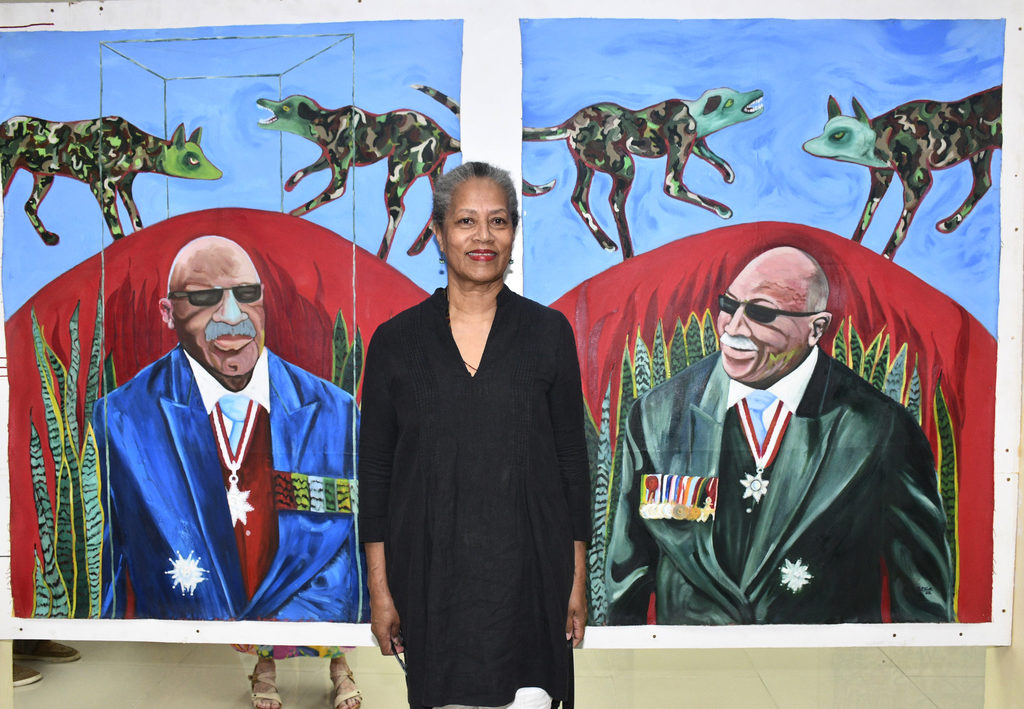WHEN Susie Elliot first picked up a brush, she never imagined it would one day become her language — a way of speaking truths about Fiji’s past and present.
Her journey into painting began far from home, in the Philippines, where she took formal classes in Chinese brushwork. That experience sparked a lifelong interest in the arts.
Later, after raising her family in New Zealand, she decided to return to school. But instead of choosing a conventional course, she decided to enrol in to an art school.
“When my children were old enough and in high school, I thought, this is my time,” Ms Elliot said.
“I wanted to study art seriously. That’s how it really began for me.”
On Wednesday this week, Ms Elliot was one of six artists who exhibited at the KUDRU exhibition in Suva.
Her works — bold, coded, and deeply political — spoke to Fiji’s history and the scars left behind by its coup culture, specifically the 1987 coup by Prime Minister Sitiveni Rabuka.
Splayed on a wall were two oil paintings, both so similar but different at the same time.
She said she first started working on them in April this year, though preparations started months earlier.
“There’s a lot of preparation that goes into the canvas before the paint goes on.
“The two works behind me are oil paintings, so they require a different process. The one in the corner is acrylic — fast-drying and easier in some ways. But each medium demands its own care.”
The paintings looked back at 1987, a year that left an indelible mark on her.
“For me, everything stopped almost literally in 1987 when we had the first coup.
“Those of us who grew up in Fiji before then remember what it was like — a paradise. After the coups, the whole feeling of the place changed.”
The two paintings were diptychs — paired canvases designed to be hung together. Their subjects alluded to the architects of Fiji’s coup culture and the militarisation of society. Figures and animals dominated the imagery, each carrying layers of coded meaning.
The most striking items that stood out, apart from the drawing of Mr Rabuka, were dogs.
Ms Elliot said they were inspired partly by a remark made earlier this year by Mr Rabuka.
“He said, ‘Who let the dogs out?’ when speaking about drugs. I took that and ran with it. The dogs here are alluding to the military — dogs of war.
“If you look closely, their coats are painted in military colours, drawing from both local and overseas uniforms.”
The blue background, too, she said, was deliberate.
It hinted at the “banner blue” of the Fijian flag, but also suggested the hills and environment that form the backdrop to her imagined landscapes.
“Everything in the canvas is coded.
“You need to stand in front of it and read it for yourself.”
Ms Elliot grew up in Fiji in the 1960s, in what she said was a golden time.
“I know I might be romanticising it a little, but it truly was beautiful. Everything changed after 1987.
“Those born after that only know today’s Fiji. But it wasn’t always like this.”
She said her paintings were not just artworks — they were calls to remember, to reflect, and to spark dialogue about what kind of Fiji the next generation would inherit.
“We want our youths to step up and have a say in how this country ought to be run.”
She said art was also about courage and the willingness to express what lay inside.
She said many young artists often felt shy about putting their thoughts to paper or canvas, especially when dealing with sensitive subjects. This shouldn’t be the case.
“Just go for it. Experiment.
“We’re fortunate to have artists here who are making their mark — from muralists like the boy Eastgate, whose work is out in the public, to others working quietly on their own.
“Just pick up a pencil and paper and start. And if your family or friends laugh at you, keep going.”
“When you paint, the work evolves on its own.
“You borrow from real life, but the moment the brush touches the canvas, the painting takes over. It begins to speak for itself.”
Ms Elliot said the artistic ‘voice’ was something Fiji badly needed to hear.



